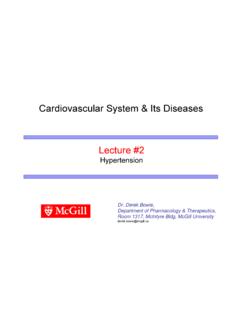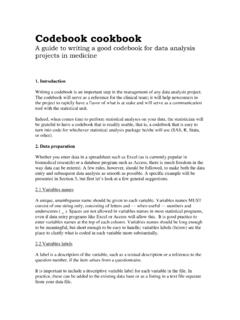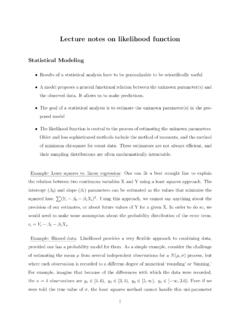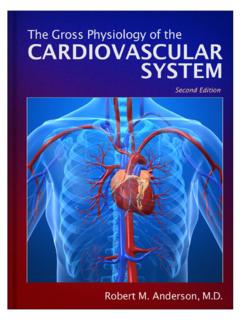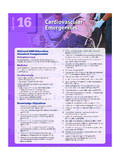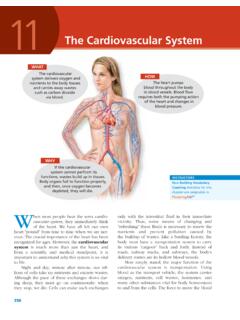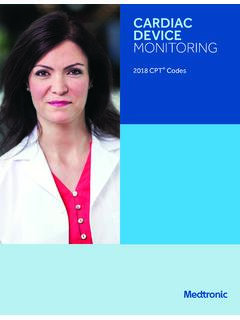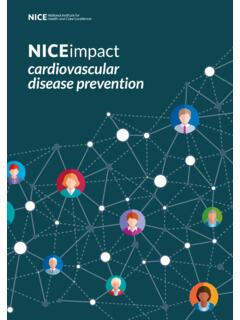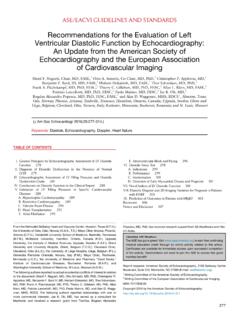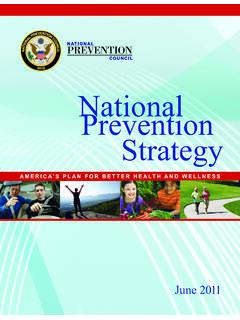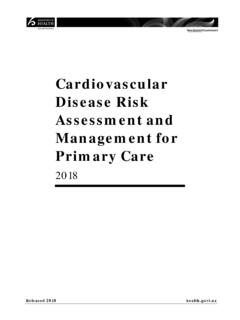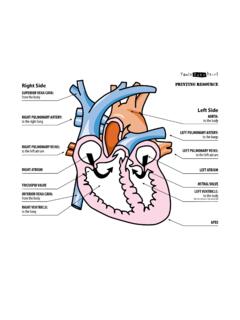Transcription of Cardiovascular System & Its Diseases Lecture #1
1 Lecture #1 Cardiovascular SystemDr. Derek Bowie,Department of Pharmacology & Therapeutics,Room 1317, McIntyre Bldg, McGill System & Its DiseasesWhy do we bother teachingCardiovascular Pharmacology???????????????????????????? ???????????????????????????????????????? ???????????????????????????????** Related Disorders*Mainly Thro Our Own HabitsSocio-Economic Status Too!Overview of Lecture Series1. Cardiovascular System2. Hypertension3. Myocardial IschemiaBits N PiecesBlood, Heart, Blood-VesselsKeeping It Under ControlHeart Rate, Blood PressureWhen Things Go WrongHypertension, Ischemia, Heart Failure, ArrhythmiasAetiologyDiagnosisTreatmentSy mpathoplegic Drugs, Diuretics, Vasodilators, Angiotensin Antagonists4. Heart Failure & Cardiac ArrhythmiasAetiologyDiagnosisTreatmentSy mptomatic:Nitrites, Calcium Channel Blockers, -BlockersProphylactic:Lipid lowering, Anti-coagulant, Anti-platelet drugsAetiologyDiagnosisTreatmentHeart Failure: Nitrites, Calcium Channel Blockers, Diuretics,Angiotensin Antagonists, -Blockers, -Receptor Agonist, Cardiac GlycosidesArrhythmias: Channel Blockers (Groups I IV), MiscellaneousWhat To Read?
2 Chapters 8 -19 Chapters 2 - 31. Components of the CV System :Blood, Heart & Blood Vessels2. Regulation:Heart Rate, Blood Pressure (Autonomic NS) & Pharmacology3. Playing Doctor:Mystery Case !!!!!!!!!!!!!!!!Don t Put the Cart Before The HorsePhysiology Then PharmacologyWhat Will YouLearn Today?There are different types of Circulatory SystemsSimple System (single-celled organisms use their surface for nutrient and gaseous exchange)Open Circulatory System (common to molluscs and arthropods; blood bathes tissues with flow being sluggish)1. Components of the CV SystemClosed Circulatory System (in echinoderms and vertebrates; blood enclosed in specialized vessels)Vertebrate Cardiovascular System (multi-chambered heart with complex valves; blood transported in vessels)1. Components of the CV SystemA Little Bit of HistoryFish:Single (2-chambers) circulatory System (gills to rest of body)Amphibians / Reptiles:Double (sometimes 3-chambers though)Birds / Mammals:Complete separation (4-chambers)4thCentury BC:Herophilus distinguished arteries from veins (blood collects in veins at death and empties from arteries.)
3 Therefore, postulated arteries carried air)2ndCentury AD:Galen assigned different functions to veins and arteries1242:Ibn Nafis first to describe blood circulation in body1628:William Harvey described circulatory System in influential book but failed to identify the capillariesHeart Rate During Embryonic DevelopmentHeart is one of the first organs to appear during development(i) BloodComponents Of BloodSome antihypertensives regulate blood volumeCellular Components Of BloodRed blood cellsMagnification x10,000 LeucocytesPlateletAnticoagulants are used to prevent further blood vessel occlusionDynamic Nature Of RBCsMagnification x 5,000 Blood ClottingSickle Cell anaemia(ii) HeartPwaveAtrial DepolarizationQRScomplexVentricular depolarizationTwaveVentricular RepolarizationNB Atrial repolarization is masked by QRScomplexAV valveclosureSemilunar valveclosureCardiac Cycle* In hypertension arterial pressure is elevated which compromises the ability of the ventricles to pump effectively *MidSystolic MurmurA midsystolicmurmurbegins shortly after the first sound, peaks in the middle of systole, and does not quite extend to the second sound.
4 It is also known as ejection murmur. The most characteristic feature of this murmur is its cessation before the second sound, thus leaving this latter sound identifiable as a discrete entity. This type of murmur is commonly heard in normal individuals, particularly in the young who usually have increased blood volumes flowing over normal HeartFoetal HeartNormal functioning heart consists of pairs of sounds. Each pair, lub-dub, lub-dub begins with the 1st sound and ends with the 2nd. The major audible components are related to mitral, tricuspid and semi-lunar valve closure. Early Systolic MurmurEarly systolic murmursbegin with the first sound and peak in the first third of systole. Early murmorshave the greatest intensity in the early part of the cycle. Common causes are a small ventricular septaldefect (VSD), or the innocent murmurs of childhood.
5 This recording is an early systolic murmurfrom a 20 year-old female with a small muscular MurmurA pan diastolic murmurbegins with the second sound and extends throughout the diastolic period. Patent ductus arteriosus(PDA) is a classical example of this murmur. This condition is usually corrected in childhood. It is heard best at base left and has both a systolic and diastolic component. It is known as a continuous of: Virtual Stethoscope Web Normal Heart BehaviorLinkLinkLinkLink(tricuspid)(Semi -lunar valves)(bicuspid)Link(iii) Blood VesselsCirculatory RoutesOne-Way Valve In A VeinSkeletal Muscle Aids Returning Blood To The HeartHemodynamic Properties Of Blood VesselsContractility is regulatedby drugsAtherosclerosis Restricts Blood Flow In VesselsCan lead to claudication(leg pain due to poor circulation)Regulating Heart Rate2 Things To Remember:Cardiac Pacemaker Activity & the Autonomic NSWhat Is The Autonomic Nervous System ?
6 Somatic NS(Voluntary)Autonomic NS(Involuntary)Sympathetic & Parasympathetic NS HaveOpposing Actions On The HeartTypical Cholinergic & Noradrenergic Nerve EndingsHomeostatic Regulation Of Heart RateMarey s Law:Inverse relationship between blood pressure & heart rateAutonomic Nervous System Regulates Heart RateMedulla provides autonomicregulation of heart rateInnervation that contributesto the Carotid Sinus & Aortic ReflexContainBaroreceptorsRegulating Blood PressureControlling Blood Pressure At Multiple Regulatory Sites Autonomic & Hormonal Control Of Cardiovascular FunctionAutonomic Loop is fast (seconds to minutes)whereasthe hormonal loop is slower (hours to days)NAME MY DISEASEC ardiovascular System & Its Diseases :Autonomic Nervous SystemThe patient is 21 yrs old and has experienced frequent episodes of blurred vision, dizziness, faintness and syncope for as long as she can remember. She is the only child; her mother has a history of two spontaneous abortions at 12 and 14 weeks of gestation and one stillborn child at 38 weeks.
7 The subject had a normal development during childhood; although she was considered apathetic and she avoided physical StudyIs this a disorder of the Sympathetic NS,Parasympathetic NS or Both? Cardiovascular System & Its Diseases :Autonomic Nervous SystemPlasma noradrenaline and adrenaline were undetectable but dopamine was 7 times normal. Upon 60ohead-up tilting, noradrenaline and adrenaline did not change (in normal subjects, they increase) but dopamine increased (usually it does not). Case StudyWhat s wrong with this patient? Cardiovascular System & Its Diseases :Autonomic Nervous SystemCase StudyThis patient has a congenital deficiency in dopamine -hydroxylase;The enzyme which converts dopamine to noradrenaline. What s Next?Disease StatesLecture # most common, asymptomaticLecture # Ischemiademand-supply imbalanceLecture # Failure multifactorialArrhythmiasimpulse abnormalityCardiovascular System And Its DiseasesWhat Have We Learned?
8 1. Components: Blood, Heart & Blood Vessels2. Regulation: Heart Rate & Blood Pressure3. Diseases : Hypertension, Angina, Heart Failure & ArrhythmiasFurther Reading?Pages 56 - 64, 99 -115, 121-129 Chapters 11 - 15
